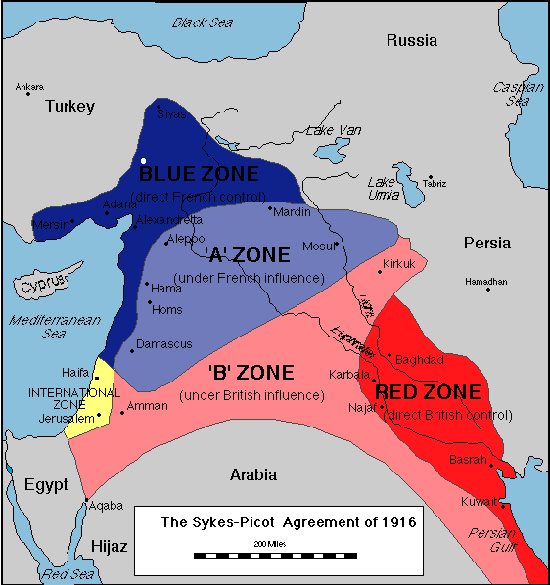Redrafting Sykes-Picot, forever a dangerous idea
Wednesday, 31 December 2014
Manuel Almeida/Al Aarabiya
Looking back on 2014, it was a tragic year for too many people in the Arab world and a sad and disappointing one to anyone concerned with the fate of the region. As in previous years, the region’s multiple crises continued to be the subject of numerous books and analyses by Arab and non-Arab commentators and experts, often putting forward solutions to tackle an endless list of pressing problems. This year, I have come across many sensible points. Yet I have also heard and read some puzzling ideas.
If I had to name the bad idea of the year, it would probably be the argument that the partition of countries such as Iraq and Syria should not only go un-opposed but, if properly managed, could be a better alternative to current situation. This idea is by no means exclusive to the year that is now ending, but it has made the rounds again now that the disintegration of Syria and Iraq (not to mention Yemen and Libya) no longer looks like such a remote possibility.
“To look at today’s sectarian tensions and violence in Iraq and Syria as an inevitable result of the unwillingness of Sunni and groups to co-habit within the same states is wrong for many reasons”
The pro-partition argument usually recalls how British and French imperialists, once the belief set in that the collapse of the Ottoman Empire was imminent, started to divide the spoils and defined many of the region’s territorial borders in complete disregard of the complex reality on the ground. Most infamous among those machinations is the British-French agreement of 1916, which came out of the proposal put forward by the young British politician Mark Sykes and negotiated by the French veteran diplomat François Georges-Picot. The Sykes-Picot agreement, as it became known, split the territories of today’s Syria, Lebanon, Iraq and Jordan into British and French spheres of control and agreed on an international administration for the territories of contemporary Palestine and Israel.
Territorial borders
Contrary to what still seems to be widely assumed, what the agreement did not do was set territorial borders. These were discussed in 1920 during the San Remo conference and most were defined much later (such as the Iraq-Syria border, in 1932), but this is a matter of factual accuracy that changes nothing today.
More important is that, at the time, the agreement was already haunted by the feeling that the end-result of such an arbitrary and arrogant plan could not be a good one, although such considerations were overlooked by the greediness of British and French imperialists. “The art of arranging how men are to live is even more complex than that of massacring them”, later admitted Georges Clemenceau, the prime minister of France between 1917 and 1920.
The same awareness of toying with disaster was also present a couple of decades after the Sykes-Picot agreement, when the British struggled to make a decision on what to do with Palestine before leaving the problem in the hands of the U.N. Back then, Foreign Office diplomats believed that the creation of two separate states in Palestine, one Arab and one Jewish, was not economically viable.
It is clear that the artificial foundations of these states and the instrumental use by European imperialists of local groups and sensitivities plays a role in today’s instability. Yet it is wrong to think that out of that artificiality no true sense of nation and nationality, even if a fragile one, was able to develop.
Sectarian tensions
To look at today’s sectarian tensions and violence in Iraq and Syria as an inevitable result of the unwillingness of Sunni and groups to co-habit within the same states is wrong for many reasons. It assumes that sectarianism is essentially a cause of the region’s troubles, instead of a symptom of other ills such as despotism, radicalism, foreign interference and poor governance. It also ignores a long history of tolerance and co-existence and it paints an inaccurate picture of what is far more complex reality. Just as simple examples, many important Iraqi tribes have Sunni and Shiite members and hundreds of thousands of Iraqi Sunni have traditionally lived in the Southeast where the Shiite predominate.
So the idea that by separating Shiite and Sunni populations into different territories could put an end to sectarian strife shows the same paternalistic mentality of the colonial era. This time, according to that logic, borders would be redrawn and millions of people would be forced to move to live alongside the same sect.
This, of course, would turn the threat of a sectarian divide in the Middle East into a self-fulfilling prophecy and hand over a victory to the instigators of sectarian hatred on both sides of the barricade. The assumption that such territorial divisions would make for better neighbours and better rulers seems also deeply flawed.
Then there are key questions such as international recognition and economic viability. Take the case of the autonomous but landlocked Kurdish region in Iraq. While it is difficult to argue that Kurdistan is not worthy of independent statehood, both challenges could yet prove too great for Iraqi Kurds’ independence ambitions.
If Iraq or Syria ever reach the point of formal partition, that would be a massive regional and international failure and not something to be welcomed as an opportunity to turn the page on the actions of European imperialists while following in their footsteps.





















